Food Quality, Sensory Attributes and Nutraceutical Value of Fresh “Osteen” Mango Fruit Grown under Mediterranean Subtropical Climate Compared to Imported Fruit
Abstract
1. Introduction
2. Materials and Methods
2.1. Experimental Design
2.2. Quality Parameters: Weight, Firmness, Total Soluble Solids, Titratable Acidity, and Decay
2.3. Total Carotenoid Content
2.4. Preparation of the Fruit Extracts
2.5. Total Phenolic Content
2.6. Total Antioxidant Activity
2.7. Sensory Analysis
2.8. Statistical Analysis
3. Results and Discussion
3.1. Quality Parameters: Weight, Firmness, Total Soluble Solids, Titratable Acidity, and Decay
3.2. Bioactive Compounds and Antioxidant Properties
3.3. Sensory Analysis
4. Conclusions
Author Contributions
Funding
Conflicts of Interest
References
- FAO—Food and Agriculture Organization of the United Nations. FAO Statistics; FAO: Rome, Italy, 2016; Available online: http://faostat.fao.org/ (accessed on 17 October 2018).
- Tharanathan, R.N.; Yashoda, H.M.; Prabha, T.N. Mango (Mangifera indica L.), The king of fruits—An overview. Food Rev. Int. 2006, 22, 95–123. [Google Scholar] [CrossRef]
- Sortino, G.; Caviglia, V.; Liguori, G.; De Pasquale, C.; Gianguzzi, G.; Farina, V. Quality Changes of Tropical and Subtropical Fresh-Cut Fruits Mix in Modified Atmosphere Packaging. Chem. Eng. Trans. 2017, 58, 397–402. [Google Scholar]
- Farina, V.; D’Asaro, A.; Mazzaglia, A.; Gianguzzi, G.; Palazzolo, E. Chemical-physical and nutritional characteristics of mature-green and mature-ripe ‘Kensington Pride’ mango fruit cultivated in Mediterranean area during cold storage. Fruits 2017, 72, 221–229. [Google Scholar] [CrossRef]
- Mossad, A.; El Helew, K.K.M.; Elsheshtawy, H.E. Mass modelling by dimension attributes for Mango (Mangifera indica cv. Zebdia) relevant to post-harvest and food plants engineering. Agric. Eng. Int. CIGR J. 2016, 18, 219–229. [Google Scholar]
- Maldonado-Celis, M.E.; Yahia, E.Y.; Bedoya, R.; Landázuri, P.; Loango, N.; Aguillón, J.; Restrepo, B.; Guerrero Ospina, J.C. Chemical Composition of Mango (Mangifera indica L.) Fruit: Nutritional and Phytochemical Compounds. Front. Plant Sci. 2019, 10, 1073. [Google Scholar] [CrossRef]
- Gentile, C.; Di Gregorio, E.; Di Stefano, V.; Mannino, G.; Perrone, A.; Avellone, G.; Farina, V. Food quality and nutraceutical value of nine cultivars of mango (Mangifera indica L.) fruits grown in Mediterranean subtropical environment. Food Chem. 2019, 277, 471–479. [Google Scholar] [CrossRef] [PubMed]
- Liguori, G.; Sortino, G.; Gianguzzi, G.; Inglese, P.; Farina, V. Evaluation of quality attributes and consumer preference of fresh or imported mangoes in Italy. AIMS Agric. Food 2018, 3, 426–440. [Google Scholar]
- Nunes, C.N.; Emond, J.P.; Brecht, J.K.; Dea, S.; Proulx, E. Quality curves for mango fruit stored at chilling and non chilling temperatures. J. Food Qual. 2007, 30, 104–120. [Google Scholar] [CrossRef]
- Medlicott, A.P.; Reynolds, S.B.; New, S.W.; Thompson, A.K. Harvest maturity effects on mango fruit ripening. Trop. Agric. 1988, 65, 153–157. [Google Scholar]
- Vanoli, M.; Grassi, M.; Spinelli, L.; Torricelli, A.; Rizzolo, A. Quality and nutraceutical properties of mango fruit: Influence of cultivar and biological age assessed by Time-resolved Reflectance Spectroscopy. Adv. Hortic. Sci. 2018, 32, 407–420. [Google Scholar]
- Kalra, S.K.; Tandon, D.K.; Singh, B.P. Handbook of fruit science and technology. In Production, Composition, Storage and Processing; Salunkhe, D.K., Kadam, S.S., Eds.; Marcel Dekker Inc.: New York, NY, USA, 1995; pp. 123–170. [Google Scholar]
- FAO—Food and Agriculture Organization of the United Nations. Medium-Term Prospects for Agricultural Commodities; FAO Commodities and Trade Technical Papers No 1; FAO: Rome, Italy, 2003. [Google Scholar]
- Sabbe, S.; Verbeke, W.; Van Damme, P. Familiarity and purchasing intention of Belgian consumers for fresh and processed tropical fruit products. Br. Food J. 2008, 110, 805–818. [Google Scholar] [CrossRef]
- Sabbe, S.; Verbeke, W.; Van Damme, P. Confirmation/disconfirmation of consumers’ expectations about fresh and processed tropical fruit products. Int. J. Food Sci. Technol. 2009, 44, 539–551. [Google Scholar] [CrossRef]
- Akhtar, S.; Mahmood, S.; Naz, S.; Nasir, M.; Saultan, M.T. Sensory evaluation of mangoes (Mangifera indica L.) Grown in different regions of Pakistan. Pakistan J. Bot. 2009, 41, 2821–2829. [Google Scholar]
- Calatrava-Requena, J.; González-Roa, M.C.; Guirado-Sánchez, E. Taste testing and consumer preferences for mango cultivars: A panel analysis. Acta Hortic. 2013, 992, 579–585. [Google Scholar] [CrossRef]
- Cheema, G.S.; Dani, P.G. Report on export of mango to Europe in 1932-3. Bombay Dep. Agric. Bull. 1934, 170, 259–325. [Google Scholar]
- Palapol, Y.; Ketsa, S.; Stevenson, D.; Cooney, J.M.; Allan, A.C.; Ferguson, I.B. Colour development and quality of mangosteen (Garcinia mangostana L.) fruit during ripening and after harvest. Postharv. Biol. Technol. 2009, 51, 349–353. [Google Scholar] [CrossRef]
- Gentile, C.; Reig, C.; Corona, O.; Todaro, A.; Mazzaglia, A.; Perrone, A.; Farina, V. Pomological Traits, sensory Profile and Nutraceutical Properties of Nine Cultivars of Loquat (Eriobotrya japonica Lindl.) Fruits Grown in Mediterranean Area. Plant Foods Hum. Nut. 2016, 71, 330–338. [Google Scholar] [CrossRef]
- Singleton, V.L.; Rossi, J.A. Colorimetry of total phenolics with phosphomo- lybdic-phosphotungstic acid reagents. Am. J. Enol. Vitic. 1965, 16, 144–158. [Google Scholar]
- Miller, N.J.; Rice-Evans, C.A. Spectrophotometric determination of anti-oxidant activity. Redox Rep. 1996, 2, 161–171. [Google Scholar] [CrossRef]
- Ruiz-Capillas, C.; Moral, A. Use of semitrained panel members in the sensory evaluation of hake (Merluccius merluccius L.) analyzed statistically. J. Food Qual. 2003, 26, 181–195. [Google Scholar] [CrossRef]
- Liguori, G.; Inglese, P.; Corona, O.; Farina, V. Effects of 1-Methylcyclopropene on postharvest quality traits, antioxidant activity and ascorbic acid content of mature-ripe mango fruits. Fruits 2017, 72, 238–246. [Google Scholar] [CrossRef]
- Gentile, C.; Perrone, A.; Attanzio, A.; Tesoriere, L.; Livrea, M.A. Sicilian pistachio (Pistacia vera L.) nut inhibits expression and release of inflammatory mediators and reverts the increase of paracellular permeability in IL-1β-exposed human intestinal epithelial cells. Eur. J. Nutr. 2015, 54, 811–821. [Google Scholar] [CrossRef] [PubMed]
- Mannino, G.; Perrone, A.; Campobenedetto, C.; Schittone, A.; Margherita Bertea, C.; Gentile, C. Phytochemical profile and antioxidative properties of Plinia trunciflora fruits: A new source of nutraceuticals. Food Chem. 2020, 307, 125515. [Google Scholar] [CrossRef]
- Morand, C.; Tomás-Barberán, F.A. Contribution of plant food bioactives in promoting health effects of plant foods: Why look at interindividual variability? Eur. J. Nutr. 2019, 58, S13–S19. [Google Scholar] [CrossRef] [PubMed]
- Shivashankara, K.S.; Isobe, S.; Al-Haq, M.I.; Takenaka, M.; Shiina, T. Fruit antioxidant activity, ascorbic acid, total phenol, quercetin, and carotene of Irwin mango fruits stored at low tempertaure after high electric field pretreatment. J. Agric. Food Chem. 2004, 52, 1281–1286. [Google Scholar] [CrossRef]
- Gentile, C.; Allegra, M.; Angileri, F.; Pintaudi, A.M.; Livrea, M.A.; Tesoriere, L. Polymeric proanthocyanidins from Sicilian pistachio (Pistacia vera L.) nut extract inhibit lipopolysaccharide-induced inflammatory response in RAW 264.7 cells. Eur. J. Nutr. 2012, 51, 353–363. [Google Scholar] [CrossRef]
- Liu, F.X.; Fu, S.F.; Bi, X.F.; Chen, F.; Liao, X.J.; Hu, X.S.; Wu, J.H. Physico- chemical and antioxidant properties of four mango (Mangifera indica L.) cultivars in China. Food Chem. 2013, 138, 396–405. [Google Scholar] [CrossRef]
- Sulaiman, S.F.; Ooi, K.L. Polyphenolic and vitamin C contents and antioxidant activities of aqueous extracts from mature-green and ripe fruit fleshes of mangifera SP. J. Agric. Food Chem. 2012, 60, 11832–11838. [Google Scholar] [CrossRef]
- De Cassia Mirela Resende Nassur, R.; Gonzalez-Moscoso, S.; Crisosto, M.G.; de Oliveira Lima, L.C.; de Barros Vilas Boas, E.V.; Crisosto, C.H. Describing Quality and Sensory Attributes of 3 Mango (Mangifera indica L.) cultivars at 3 ripeness stages based on firmness. J. Food Sci. 2015, 80, 2055–2063. [Google Scholar]
- Brummell, D.A.; Dal Cin, V.; Lurie, S.; Crisosto, C.H.; Labavitch, J.M. Cell wall metabolism during the development of chilling injury in cold-storage peach fruit: Association of mealiness with arrested disassembly of cell wall pectins. J. Exp. Bot. 2004, 55, 2041–2052. [Google Scholar] [CrossRef]
- Goulao, L.F.; Oliveira, C.M. Cell wall modifications during fruit ripening: When a fruit is not the fruit. Trends Food Sci. Technol. 2008, 19, 4–25. [Google Scholar] [CrossRef]
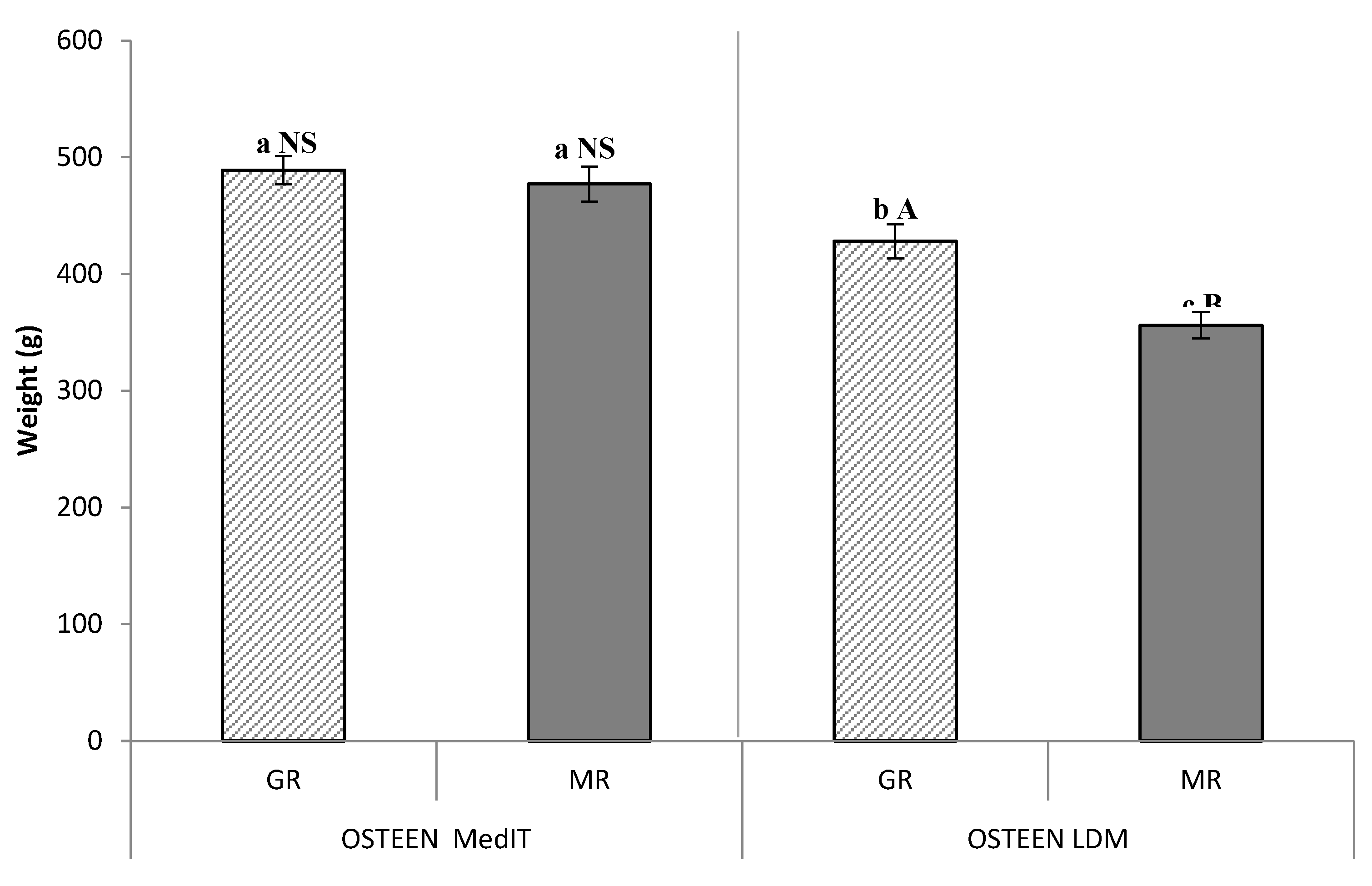
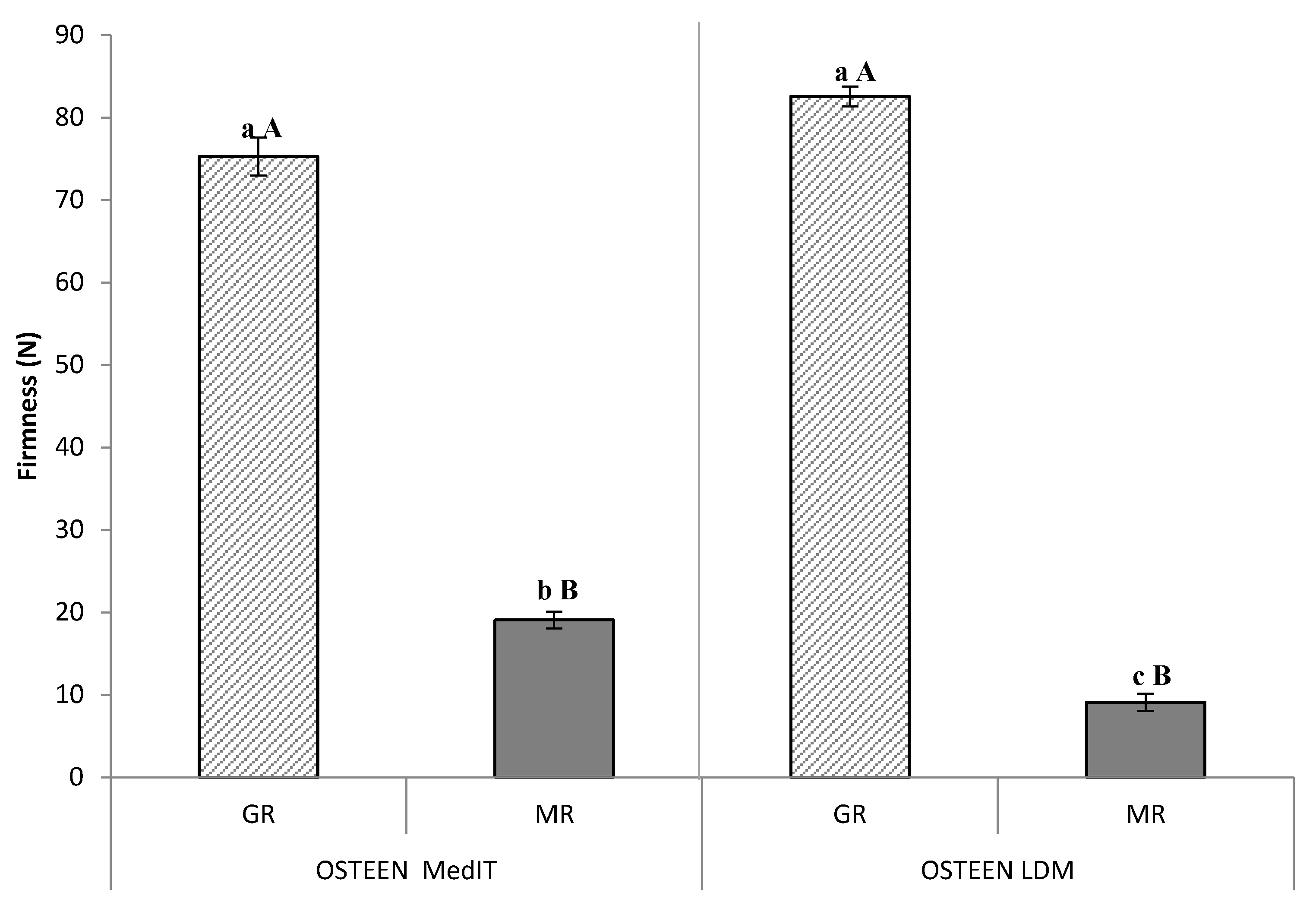
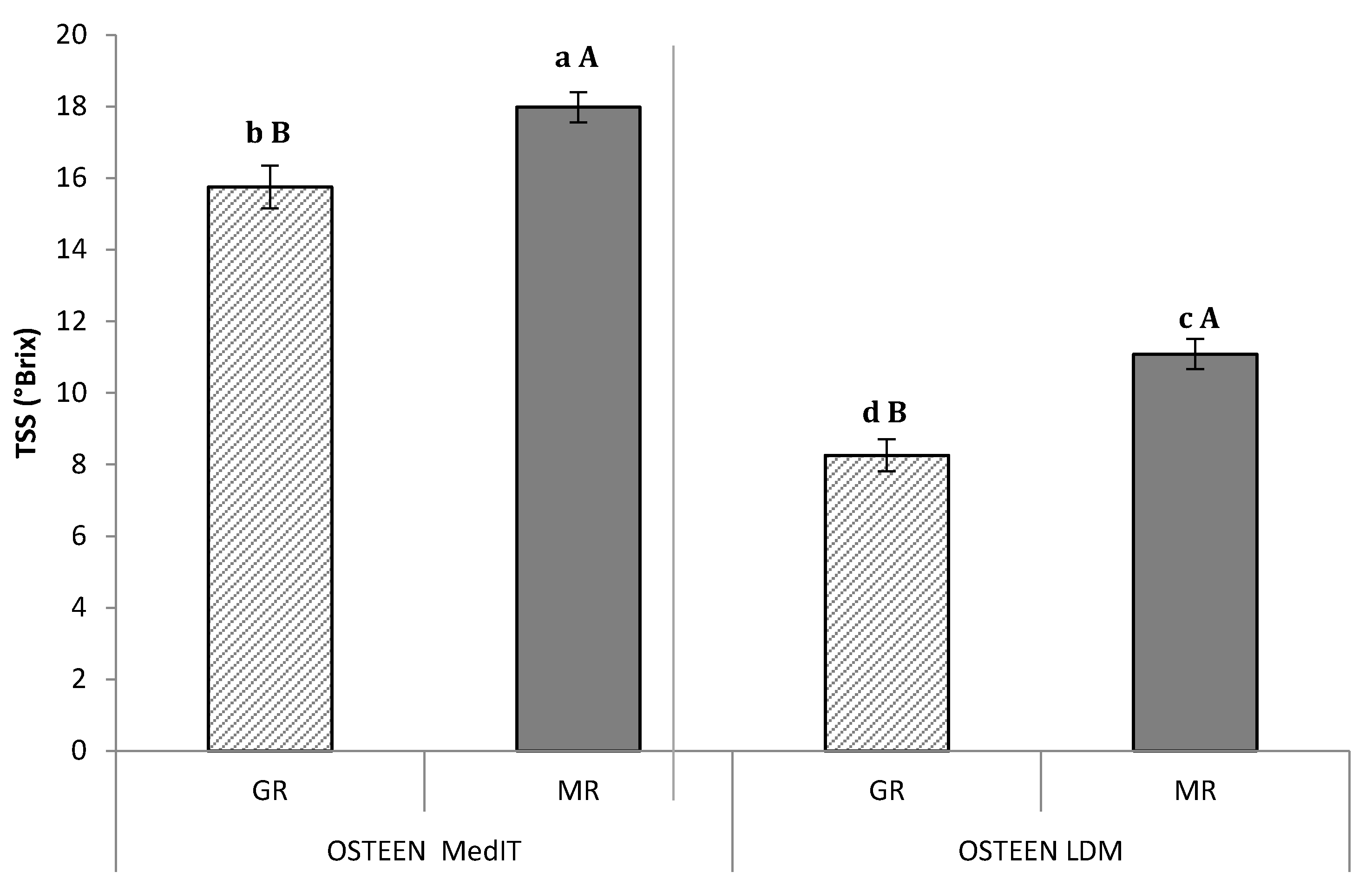
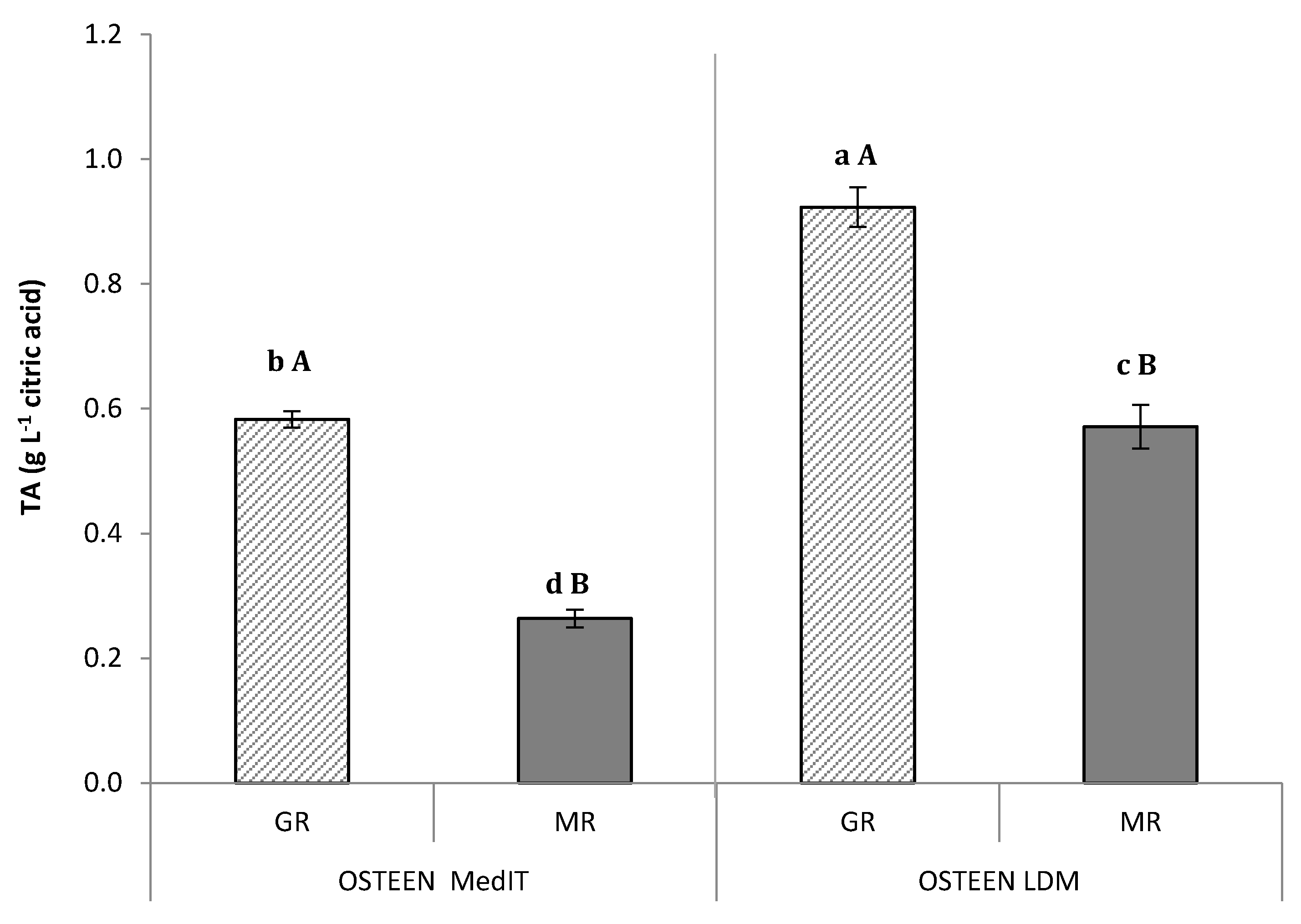
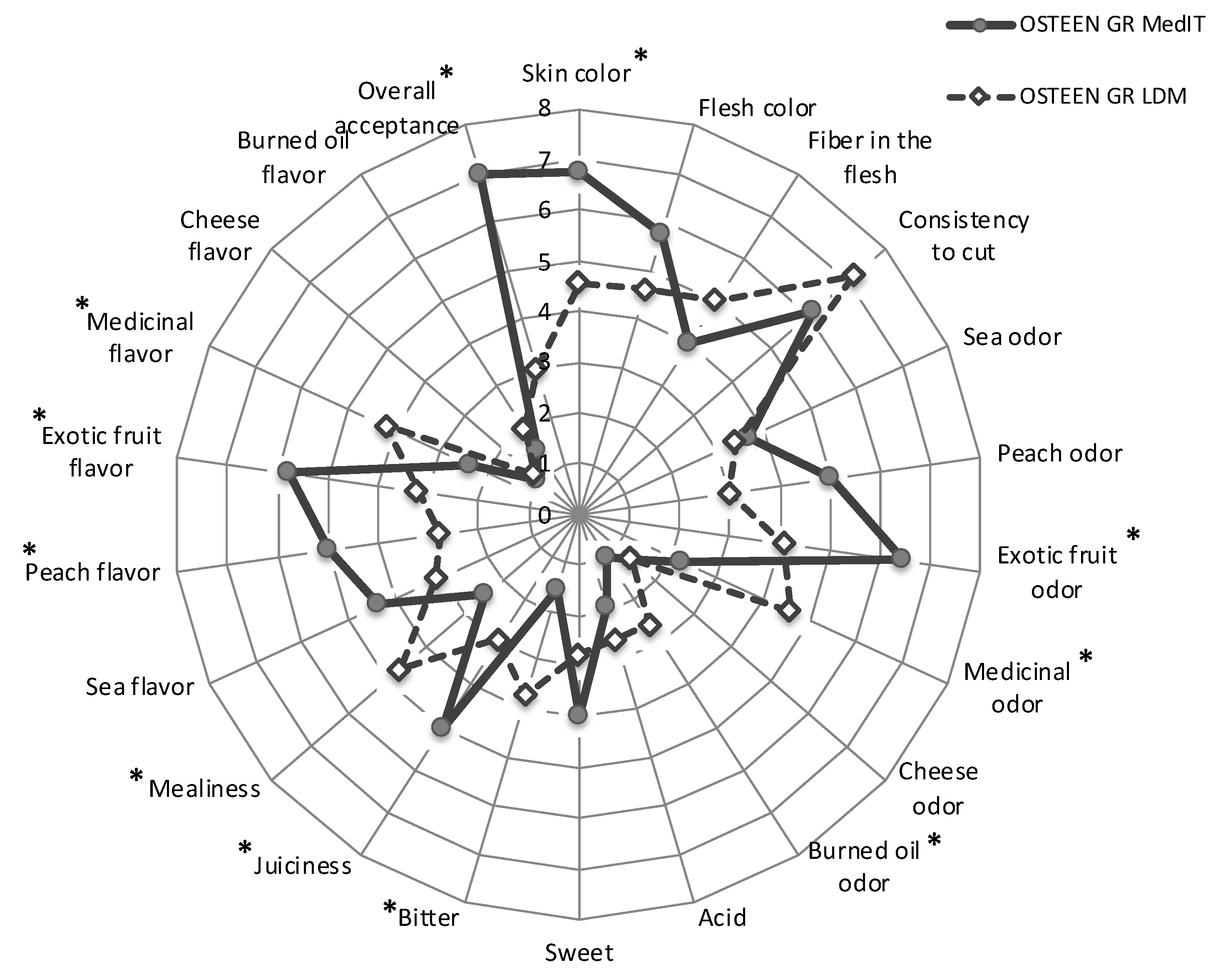
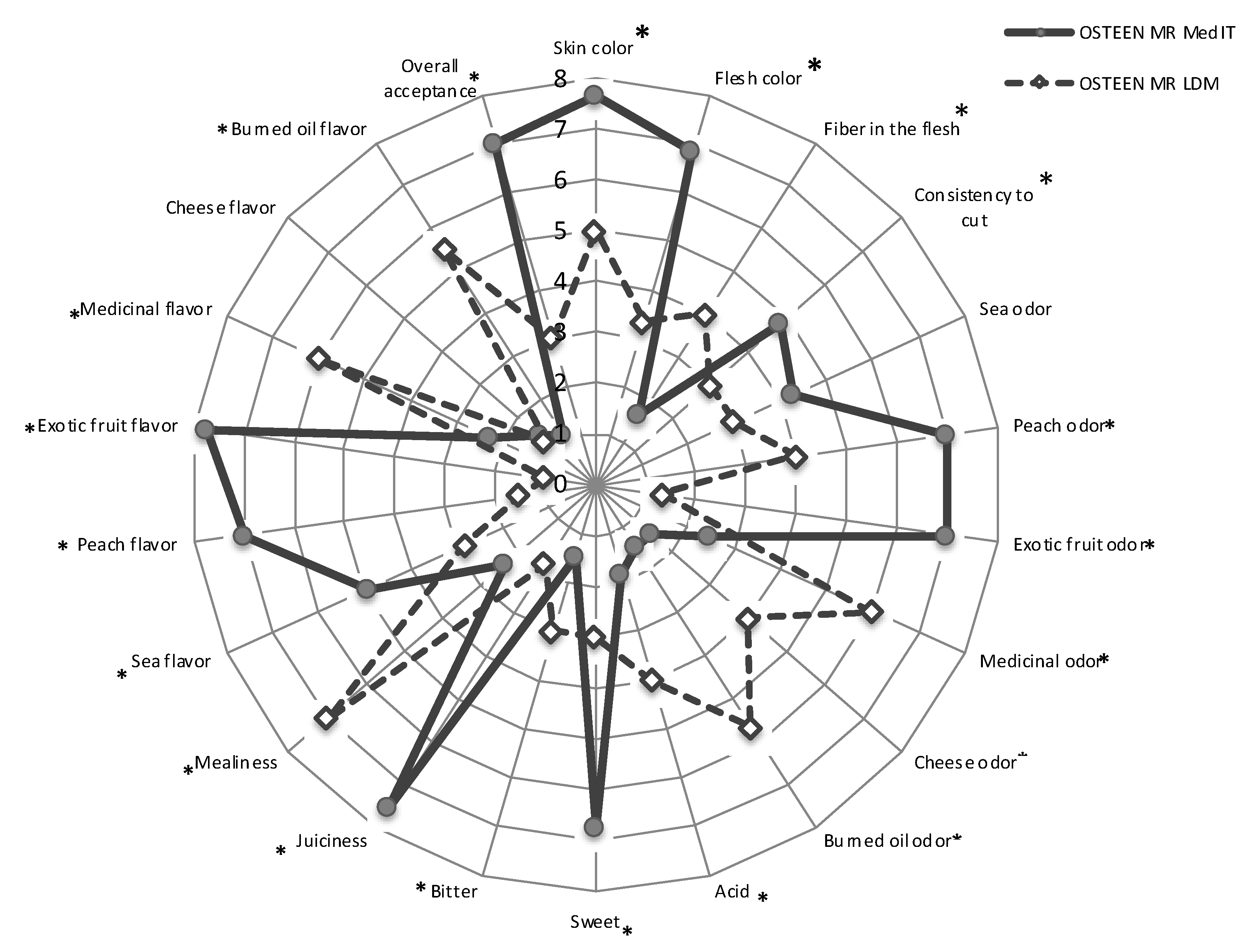
| TCC | TPC | TAA | ||||
|---|---|---|---|---|---|---|
| (μg β-Carotene eq per g of FW) | (mg GAE per 100g of FW) | (μmol TE per 100 g of FW) | ||||
| GR | MR | GR | MR | GR | MR | |
| OSTEEN MedIT | 1.38 ± 0.07 bB | 13.64 ± 0.12 aA | 16.63 ± 1.94 bB | 28.29 ± 1.24 aA | 93.07 ± 2.43 bA | 195.45 ± 5.32 aA |
| OSTEEN LDM | 6.17 ± 0.09 bA | 8.93 ± 0.08 aB | 20.39 ± 0.39 aA | 20.11 ± 1.86 aB | 91.49 ± 1.97 bA | 99.90 ± 2.03 aB |
© 2020 by the authors. Licensee MDPI, Basel, Switzerland. This article is an open access article distributed under the terms and conditions of the Creative Commons Attribution (CC BY) license (http://creativecommons.org/licenses/by/4.0/).
Share and Cite
Liguori, G.; Gentile, C.; Sortino, G.; Inglese, P.; Farina, V. Food Quality, Sensory Attributes and Nutraceutical Value of Fresh “Osteen” Mango Fruit Grown under Mediterranean Subtropical Climate Compared to Imported Fruit. Agriculture 2020, 10, 103. https://doi.org/10.3390/agriculture10040103
Liguori G, Gentile C, Sortino G, Inglese P, Farina V. Food Quality, Sensory Attributes and Nutraceutical Value of Fresh “Osteen” Mango Fruit Grown under Mediterranean Subtropical Climate Compared to Imported Fruit. Agriculture. 2020; 10(4):103. https://doi.org/10.3390/agriculture10040103
Chicago/Turabian StyleLiguori, Giorgia, Carla Gentile, Giuseppe Sortino, Paolo Inglese, and Vittorio Farina. 2020. "Food Quality, Sensory Attributes and Nutraceutical Value of Fresh “Osteen” Mango Fruit Grown under Mediterranean Subtropical Climate Compared to Imported Fruit" Agriculture 10, no. 4: 103. https://doi.org/10.3390/agriculture10040103
APA StyleLiguori, G., Gentile, C., Sortino, G., Inglese, P., & Farina, V. (2020). Food Quality, Sensory Attributes and Nutraceutical Value of Fresh “Osteen” Mango Fruit Grown under Mediterranean Subtropical Climate Compared to Imported Fruit. Agriculture, 10(4), 103. https://doi.org/10.3390/agriculture10040103









